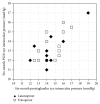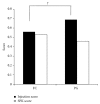Effect on intraocular pressure of switching from latanoprost and travoprost monotherapy to timolol fixed combinations in patients with normal-tension glaucoma
- PMID: 25505978
- PMCID: PMC4258362
- DOI: 10.1155/2014/720385
Effect on intraocular pressure of switching from latanoprost and travoprost monotherapy to timolol fixed combinations in patients with normal-tension glaucoma
Abstract
Purpose. To evaluate the effect on intraocular pressure (IOP) of switching from latanoprost and travoprost monotherapy to timolol fixed combinations in Japanese patients with normal-tension glaucoma (NTG). Methods. 27 NTG patients (54 eyes) were compared IOP, superficial punctuate keratitis (SPK) scores, and conjunctival injection scores in eyes treated with prostaglandin (PG) or PG analog/beta-blocker (PG/b) fixed-combination 6 months after the change in therapy. Results. The mean baseline intraocular pressure was 17.4 ± 1.59 mmHg in eyes receiving PG therapy only and 17.4 ± 1.69 mmHg in eyes switched to PG/b. Switching to fixed combination therapy from PG monotherapy, the mean IOP was 13.1 ± 1.79 mmHg (P < 0.001) (-24.71% reduction from baseline) at 6 months. The mean conjunctival injection score was 0.69 for eyes on PG monotherapy and 0.56 for eyes on fixed combination therapy (P = 0.028). The mean SPK scores were 0.46 and 0.53. This difference was not statistically significant (P = 0.463). Conclusions. Switching from PG monotherapy to PG/b fixed combination therapy for NTG resulted in a greater intraocular pressure reduction than PG alone without increasing the number of instillations.
Figures
Similar articles
-
Fixed Combination of Travoprost and Timolol Maleate Reduces Intraocular Pressure in Japanese Patients with Primary Open-Angle Glaucoma or Ocular Hypertension: A Prospective Multicenter Open-Label Study.Adv Ther. 2015 Sep;32(9):823-37. doi: 10.1007/s12325-015-0246-9. Epub 2015 Sep 30. Adv Ther. 2015. PMID: 26424331 Free PMC article. Clinical Trial.
-
Switching to Preservative-Free Tafluprost/Timolol Fixed-Dose Combination in the Treatment of Open-Angle Glaucoma or Ocular Hypertension: Subanalysis of Data from the VISIONARY Study According to Baseline Monotherapy Treatment.Adv Ther. 2022 Aug;39(8):3501-3521. doi: 10.1007/s12325-022-02166-6. Epub 2022 May 7. Adv Ther. 2022. PMID: 35524840 Free PMC article.
-
[Efficacy of latanoprost versus travoprost assessed by daily intraocular pressure curve].Arq Bras Oftalmol. 2009 Jan-Feb;72(1):13-7. doi: 10.1590/s0004-27492009000100003. Arq Bras Oftalmol. 2009. PMID: 19347115 Portuguese.
-
Latanoprost : an update of its use in glaucoma and ocular hypertension.Drugs Aging. 2003;20(8):597-630. doi: 10.2165/00002512-200320080-00005. Drugs Aging. 2003. PMID: 12795627 Review.
-
The efficacy of the fixed combination of latanoprost and timolol versus other fixed combinations for primary open-angle glaucoma and ocular hypertension: A systematic review and meta-analysis.PLoS One. 2020 Feb 27;15(2):e0229682. doi: 10.1371/journal.pone.0229682. eCollection 2020. PLoS One. 2020. PMID: 32106236 Free PMC article.
Cited by
-
Comparison of the Effects of Dorzolamide/Timolol Fixed Combination versus Latanoprost on Intraocular Pressure and Ocular Perfusion Pressure in Patients with Normal-Tension Glaucoma: A Randomized, Crossover Clinical Trial.PLoS One. 2016 Jan 12;11(1):e0146680. doi: 10.1371/journal.pone.0146680. eCollection 2016. PLoS One. 2016. PMID: 26756747 Free PMC article. Clinical Trial.
-
Fixed Combination of Travoprost and Timolol Maleate Reduces Intraocular Pressure in Japanese Patients with Primary Open-Angle Glaucoma or Ocular Hypertension: A Prospective Multicenter Open-Label Study.Adv Ther. 2015 Sep;32(9):823-37. doi: 10.1007/s12325-015-0246-9. Epub 2015 Sep 30. Adv Ther. 2015. PMID: 26424331 Free PMC article. Clinical Trial.
References
-
- Japan Glaucoma Society Glaucoma Diagnosis Guidelines Committee Glaucoma diagnosis guidelines. 2012;116(1):3–46. - PubMed
-
- Krupin T., Liebmann J. M., Greenfield D. S., Ritch R., Gardiner S. Low-pressure Glaucoma Treatment Study Group: a randomized trial of brimonidine versus timolol in preserving visual function: results from the Low-Pressure Glaucoma Treatment Study. The American Journal of Ophthalmology. 2011;151(6):671–681. doi: 10.1016/j.ajo.2011.04.001. - DOI - PubMed
-
- Fukuchi T., Yoshino T., Seki M., Tanaka T., Togano T., Ueda J., Hara H., Shirakashi M., Abe H. Improvement of glaucoma medication and the follow-up intraocular pressure in primary open-angle glaucomatous eyes in Japan. Folia Japonica de Ophthalmologica Clinica. 2011;4(3):209–215.
LinkOut - more resources
Full Text Sources
Other Literature Sources







